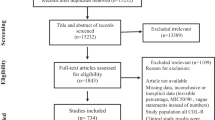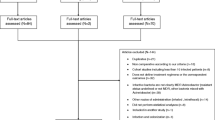Abstract
We conducted a systematic review and meta-analysis to determine the rate of polymyxin resistance among Acinetobacter baumannii isolates causing infection in hospitalized patients around the world during the period of 2010–2019. The systematic review was performed on September 1, 2019, using PubMed/MEDLINE, Scopus, and Web of Science; studies published after January 1, 2010, were selected. The data were summarized in tables, critically analyzed, and treated statistically using the RStudio® Software with Meta package and Metaprop Command. After applying exclusion factors, 41 relevant studies were selected from 969 articles identified on literature search. The overall rate of polymyxin-resistant A. baumannii (PRAB) related to hospitalized patients was estimated to be 13% (95% CI, 0.06–0.27), where a higher rate was observed in America (29%; 95% CI, 0.12–0.55), followed by Europe (13%; 95% CI, 0.02–0.52), and Asia (10%; 95% CI, 0.02–0.32). The extensive use of polymyxins on veterinary to control bacterial infection and growth promotion, as well as the resurgence in prescription and use of polymyxins in the clinics against carbapenem-resistant gram-negative bacteria, may have contributed to the increased incidence of PRAB. The findings of this meta-analysis revealed that the rate of PRAB recovered from hospitalized patients is distinctively high. Thus, action needs to be taken to develop strategies to combat the clinical incidence of PRAB-induced hospital infections.




Similar content being viewed by others
References
Howard A, O’Donoghue M, Feeney A, Sleator RD (2012) Acinetobacter baumannii. Virulence 3:243–250. https://doi.org/10.4161/viru.19700
Sousa C, Botelho J, Silva L et al (2014) MALDI-TOF MS and chemometric based identification of the Acinetobacter calcoaceticus-Acinetobacter baumannii complex species. Int J Med Microbiol 304:669–677. https://doi.org/10.1016/j.ijmm.2014.04.014
Jung J, Park W (2015) Acinetobacter species as model microorganisms in environmental microbiology: current state and perspectives. Appl Microbiol Biotechnol 99:2533–2548. https://doi.org/10.1007/s00253-015-6439-y
Espinal P, Martí S, Vila J (2012) Effect of biofilm formation on the survival of Acinetobacter baumannii on dry surfaces. J Hosp Infect 80:56–60. https://doi.org/10.1016/j.jhin.2011.08.013
Urban C, Go E, Mariano N et al (1993) Effect of sulbactam on infections caused by imipenem-resistant Acinetobacter calcoaceticus biotype anitratus. J Infect Dis 167:448–451
Lima WG, Silva Alves GC, Sanches C et al (2019) Carbapenem-resistant Acinetobacter baumannii in patients with burn injury: a systematic review and meta-analysis. Burns. https://doi.org/10.1016/j.burns.2019.07.006
Vogler K, Studer RO (1966) The chemistry of the polymyxin antibiotics. Experientia 22:345–354
Olaitan AO, Morand S, Rolain J-M (2014) Mechanisms of polymyxin resistance: acquired and intrinsic resistance in bacteria. Front Microbiol 5:643. https://doi.org/10.3389/fmicb.2014.00643
Falagas ME, Kasiakou SK, Saravolatz LD (2005) Colistin: the revival of polymyxins for the management of multidrug-resistant gram-negative bacterial infections. Clin Infect Dis 40:1333–1341. https://doi.org/10.1086/429323
Yu Y, Fei A, Wu Z et al (2017) Intravenous polymyxins: revival with puzzle. Biosci Trends 11:370–382. https://doi.org/10.5582/bst.2017.01188
Lima WG, Alves MC, Cruz WS, Paiva MC (2018) Chromosomally encoded and plasmid-mediated polymyxins resistance in Acinetobacter baumannii: a huge public health threat. Eur J Clin Microbiol Infect Dis 37:1009–1019. https://doi.org/10.1007/s10096-018-3223-9
Adams MD, Nickel GC, Bajaksouzian S et al (2009) Resistance to colistin in Acinetobacter baumannii associated with mutations in the PmrAB two-component system. Antimicrob Agents Chemother 53:3628–3634. https://doi.org/10.1128/AAC.00284-09
Moffatt JH, Harper M, Harrison P et al (2010) Colistin resistance in Acinetobacter baumannii is mediated by complete loss of lipopolysaccharide production. Antimicrob Agents Chemother 54:4971–4977. https://doi.org/10.1128/AAC.00834-10
Hood MI, Becker KW, Roux CM et al (2013) Genetic determinants of intrinsic colistin tolerance in Acinetobacter baumannii. Infect Immun 81:542–551. https://doi.org/10.1128/IAI.00704-12
Bojkovic J, Richie DL, Six DA et al (2016) Characterization of an Acinetobacter baumannii lptD deletion strain: permeability defects and response to inhibition of lipopolysaccharide and fatty acid biosynthesis. J Bacteriol 198:731–741. https://doi.org/10.1128/JB.00639-15
Nhu NTK, Riordan DW, Nhu TDH et al (2016) The induction and identification of novel Colistin resistance mutations in Acinetobacter baumannii and their implications. Sci Rep 6:28291. https://doi.org/10.1038/srep28291
Potron A, Vuillemenot J-B, Puja H et al (2019) ISAba1-dependent overexpression of eptA in clinical strains of Acinetobacter baumannii resistant to colistin. J Antimicrob Chemother 74:2544–2550. https://doi.org/10.1093/jac/dkz241
Higgins JPT, Green S (eds) (2011) Cochrane handbook for systematic reviews of interventions Version 5.1.0 [updated March 2011]. The Cochrane Collaboration. Available from www.handbook.cochrane.org
Liberati A, Altman DG, Tetzlaff J et al (2009) The PRISMA statement for reporting systematic reviews and meta-analyses of studies that evaluate healthcare interventions: explanation and elaboration. BMJ 339:b2700. https://doi.org/10.1136/bmj.b2700
Eriksen MB, Frandsen TF (2018) The impact of patient, intervention, comparison, outcome (PICO) as a search strategy tool on literature search quality: a systematic review. J Med Libr Assoc 106:420–431. https://doi.org/10.5195/jmla.2018.345
Landis R, Koch GG (1977) The measurement of observer agreement for categorical data. Biometrics 33:159–174
Vaez H, Sahebkar A, Khademi F (2019) Carbapenem-resistant Klebsiella Pneumoniae in Iran: a systematic review and meta-analysis. J Chemother 31:1–8. https://doi.org/10.1080/1120009X.2018.1533266
Kaye KS, Pogue JM, Tran TB et al (2016) Agents of last resort: polymyxin resistance. Infect Dis Clin N Am 30:391–414. https://doi.org/10.1016/j.idc.2016.02.005
Zilberberg MD, Kollef MH, Shorr AF, Zilberberg MD (2016) Secular trends in Acinetobacter baumannii resistance in respiratory and blood stream specimens in the United States, 2003 to 2012: a survey study. J Hosp Med 11:21–26. https://doi.org/10.1002/jhm.2477
Liu Y-Y, Wang Y, Walsh TR et al (2016) Emergence of plasmid-mediated colistin resistance mechanism MCR-1 in animals and human beings in China: a microbiological and molecular biological study. Lancet Infect Dis 16:161–168. https://doi.org/10.1016/S1473-3099(15)00424-7
Wang X, Wang Y, Zhou Y et al (2018) Emergence of a novel mobile colistin resistance gene, mcr-8, in NDM-producing Klebsiella pneumoniae. Emerg Microbes Infect 7:122. https://doi.org/10.1038/s41426-018-0124-z
Sun J, Zhang H, Liu Y-H, Feng Y (2018) Towards understanding MCR-like colistin resistance. Trends Microbiol 26:794–808. https://doi.org/10.1016/j.tim.2018.02.006
Kieffer N, Royer G, Decousser J-W et al (2019) mcr-9, an inducible gene encoding an acquired phosphoethanolamine transferase in Escherichia coli , and its origin. Antimicrob Agents Chemother. https://doi.org/10.1128/AAC.00965-19
Carroll LM, Gaballa A, Guldimann C et al (2019) Identification of novel mobilized colistin resistance gene mcr-9 in a multidrug-resistant, colistin-susceptible salmonella enterica serotype typhimurium isolate. MBio 10. https://doi.org/10.1128/mBio.00853-19
Mendes Oliveira VR, Paiva MC, Lima WG (2019) Plasmid-mediated colistin resistance in Latin America and Caribbean: a systematic review. Travel Med Infect Dis 31. https://doi.org/10.1016/j.tmaid.2019.07.015
Dafopoulou K, Vourli S, Tsakris A, Pournaras S (2019) An update on polymyxin susceptibility testing methods for Acinetobacter baumannii. Expert Rev Anti-Infect Ther 17:699–713. https://doi.org/10.1080/14787210.2019.1667230
(2016) EUCAST. Recommendations for colistin (polymyxin E) MIC testing-joint EUCAST and CLSI recommendation. http://www.eucast.org/fileadmin/src/media/PDFs/EUCAST_files/General_documents/Recommendations_for_MIC_determination_of_colistin_March_2016.pdf. Accessed 17 Nov 2019
Hejnar P, Kolár M, Hájek V (1999) Characteristics of Acinetobacter strains (phenotype classification, antibiotic susceptibility and production of beta-lactamases) isolated from haemocultures from patients at the teaching hospital in Olomouc. Acta Univ Palacki Olomuc Fac Med 142:73–77
Li Z, Cao Y, Yi L et al (2019) Emergent polymyxin resistance: end of an era? Open Forum Infect Dis 6. https://doi.org/10.1093/ofid/ofz368
Giamarellou H (2016) Epidemiology of infections caused by polymyxin-resistant pathogens. Int J Antimicrob Agents 48:614–621. https://doi.org/10.1016/j.ijantimicag.2016.09.025
Kempf I, Fleury MA, Drider D et al (2013) What do we know about resistance to colistin in Enterobacteriaceae in avian and pig production in Europe? Int J Antimicrob Agents 42:379–383. https://doi.org/10.1016/j.ijantimicag.2013.06.012
Tenhagen B-A, Werner N, Käsbohrer A, Kreienbrock L (2018) Übertragungswege resistenter Bakterien zwischen Tieren und Menschen und deren Bedeutung – Antibiotikaresistenz im One-Health-Kontext. Bundesgesundheitsbl Gesundheitsforsch Gesundheitsschutz 61:515–521. https://doi.org/10.1007/s00103-018-2717-z
Catry B, Cavaleri M, Baptiste K et al (2015) Use of colistin-containing products within the European Union and European Economic Area (EU/EEA): development of resistance in animals and possible impact on human and animal health. Int J Antimicrob Agents 46:297–306. https://doi.org/10.1016/j.ijantimicag.2015.06.005
Wong MHY, Chan EWC, Chen S (2015) Evolution and dissemination of OqxAB-like efflux pumps, an emerging quinolone resistance determinant among members of Enterobacteriaceae. Antimicrob Agents Chemother 59:3290–3297. https://doi.org/10.1128/AAC.00310-15
Raro OHF, Gallo SW, Ferreira CAS et al (2017) Carbapenem-resistant Acinetobacter baumannii contamination in an intensive care unit. Rev Soc Bras Med Trop 50:167–172. https://doi.org/10.1590/0037-8682-0329-2016
Dafopoulou K, Tsakris A, Pournaras S (2018) Changes in antimicrobial resistance of clinical isolates of Acinetobacter baumannii group isolated in Greece, 2010-2015. J Med Microbiol 67:496–498. https://doi.org/10.1099/jmm.0.000708
Reddy T, Chopra T, Marchaim D et al (2010) Trends in antimicrobial resistance of Acinetobacter baumannii isolates from a metropolitan Detroit health system. Antimicrob Agents Chemother 54:2235–2238. https://doi.org/10.1128/AAC.01665-09
Ko KS, Choi Y, Lee J-Y (2017) Old drug, new findings: colistin resistance and dependence of Acinetobacter baumannii. Precis Futur Med 1:159–167. https://doi.org/10.23838/pfm.2017.00184
Kim UJ, Kim HK, An JH et al (2014) Update on the epidemiology, treatment, and outcomes of carbapenem-resistant Acinetobacter infections. Chonnam Med J 50:37–44. https://doi.org/10.4068/cmj.2014.50.2.37
(ECDC) EC for DP and C (2014) Antimicrobial resistance surveillance in Europe 2013. Annual report of the European Antimicrobial Resistance Surveillance Network (EARS-Net), EARS-Net 2. Stockholm, Sweden
Gales AC, Jones RN, Sader HS (2011) Contemporary activity of colistin and polymyxin B against a worldwide collection of Gram-negative pathogens: results from the SENTRY Antimicrobial Surveillance Program (2006-09). J Antimicrob Chemother 66:2070–2074. https://doi.org/10.1093/jac/dkr239
Ko KS, Suh JY, Kwon KT et al (2007) High rates of resistance to colistin and polymyxin B in subgroups of Acinetobacter baumannii isolates from Korea. J Antimicrob Chemother 60:1163–1167. https://doi.org/10.1093/jac/dkm305
Mahmoudi S, Mahzari M, Banar M et al (2017) Antimicrobial resistance patterns of Gram-negative bacteria isolated from bloodstream infections in an Iranian referral paediatric hospital: a 5.5-year study. J Glob Antimicrob Resist 11:17–22. https://doi.org/10.1016/j.jgar.2017.04.013
Strateva T, Sirakov I, Stoeva T et al (2019) Carbapenem-resistant Acinetobacter baumannii: current status of the problem in four Bulgarian university hospitals (2014–2016). J Glob Antimicrob Resist 16:266–273. https://doi.org/10.1016/j.jgar.2018.10.027
(ECDC) EC for DP and C (2014) ECDC surveillance report: surveillance of antimicrobial consumption in Europe 2012. In: Stockholm. http://www.ecdc.europa.eu/. Accessed 16 Nov 2019
Loureiro RJ, Roque F, Teixeira Rodrigues A et al (2016) O uso de antibióticos e as resistências bacterianas: breves notas sobre a sua evolução. Rev Port Saúde Pública 34:77–84. https://doi.org/10.1016/J.RPSP.2015.11.003
Wirtz VJ, Dreser A, Gonzales R (2010) Trends in antibiotic utilization in eight Latin American countries, 1997-2007. Rev Panam Salud Publica 27:219–225
Van Boeckel TP, Brower C, Gilbert M et al (2015) Global trends in antimicrobial use in food animals. Proc Natl Acad Sci U S A 112:5649–5654. https://doi.org/10.1073/pnas.1503141112
Kakkar M, Chatterjee P, Chauhan AS et al (2018) Antimicrobial resistance in South East Asia: time to ask the right questions. Glob Health Action 11:1483637. https://doi.org/10.1080/16549716.2018.1483637
Liu Y, Liu J-H (2018) Monitoring colistin resistance in food animals, an urgent threat. Expert Rev Anti-Infect Ther 16:443–446. https://doi.org/10.1080/14787210.2018.1481749
Acknowledgments
We thank UFSJ/PPGCF, UFMG/Pharmacy school-PPGCF, and UFMG/Department of Chemistry-PPGITB for the availability of bibliographic support. W.G.L. is grateful to Coordenação de Aperfeiçoamento de Pessoal do Nível Superior (CAPES) for a Ph.D. fellowship.
Author information
Authors and Affiliations
Contributions
All authors contributed to the development, analysis, and drafting of this article.
Corresponding author
Ethics declarations
Conflict of interest
The authors declare that they have no conflicts of interest.
Ethical approval
This article does not contain any studies with human participants or animals performed by any of the authors.
Additional information
Publisher’s note
Springer Nature remains neutral with regard to jurisdictional claims in published maps and institutional affiliations.
Electronic supplementary material
ESM 1
(DOCX 34 kb)
Rights and permissions
About this article
Cite this article
Lima, W.G., Brito, J.C.M., Cardoso, B.G. et al. Rate of polymyxin resistance among Acinetobacter baumannii recovered from hospitalized patients: a systematic review and meta-analysis. Eur J Clin Microbiol Infect Dis 39, 1427–1438 (2020). https://doi.org/10.1007/s10096-020-03876-x
Received:
Accepted:
Published:
Issue Date:
DOI: https://doi.org/10.1007/s10096-020-03876-x




